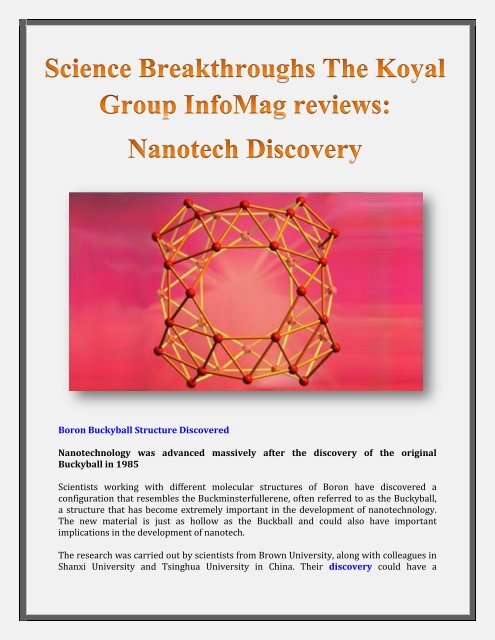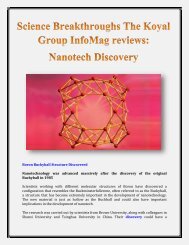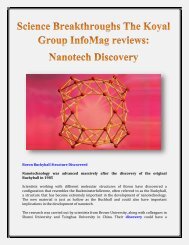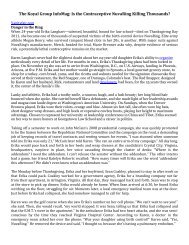o_18u1usnv41venn751v4b17nh17gsa.pdf
Create successful ePaper yourself
Turn your PDF publications into a flip-book with our unique Google optimized e-Paper software.
Boron Buckyball Structure Discovered<br />
Nanotechnology was advanced massively after the discovery of the original<br />
Buckyball in 1985<br />
Scientists working with different molecular structures of Boron have discovered a<br />
configuration that resembles the Buckminsterfullerene, often referred to as the Buckyball,<br />
a structure that has become extremely important in the development of nanotechnology.<br />
The new material is just as hollow as the Buckball and could also have important<br />
implications in the development of nanotech.<br />
The research was carried out by scientists from Brown University, along with colleagues in<br />
Shanxi University and Tsinghua University in China. Their discovery could have a
profound impact on the future of nanotechnology, but for now there is no obvious usage for<br />
the molecular structure they discovered.<br />
Endless combinations achieve result<br />
There has been a theoretical model for a boron molecule with similar properties to the<br />
Buckyball, but it had not been observed in experiments until the work by these<br />
researchers. The research involved the computer modelling of over 10,000 structures of<br />
Boron, identifying each by its binding energy. The energies of actual molecules were then<br />
tested using a process called photoelectron spectroscopy, allowing the structures to be<br />
identified.<br />
The experiment returned two 40-atom structures formed by Boron. The first is the<br />
aforementioned ball-shaped cluster. The second is described as a semi-flat molecule by the<br />
researchers. The boron ball is of the most importance because of the theoretical model that<br />
has pointed to it for years, and the fact that it resembles the Buckyball, the progenitor of so<br />
many nanotechnology discoveries.<br />
The 40-atom hollow structure is being called a borospherene by the scientists that<br />
discovered it. A paper concerning its discovery and the experiments that led to it, appears<br />
in the scientific journal Nature Chemistry.<br />
Buckyball: New material may lead to new discoveries<br />
The Buckminsterfullerene was discovered in 1985 and gave rise to much of<br />
nanotechnology’s foundation. The structure spurred the search and discovery of other<br />
forms of carbon with unusual properties. Carbon nano-tubes, a science fiction answer to<br />
many of the world’s problems and graphene, a thin layer of carbon with incredible<br />
strength, that has been touted as one of the material s that will define the twenty-first<br />
century, were both discovered immediately after the Buckminsterfullerene.<br />
Lai-Sheng Wang, a professor of chemistry at Brown University, was one of those who led<br />
the research. He has no idea about the applications of the molecule, but is proud of the<br />
achievement, and excited by it, in and of itself. According to the researcher, “As a chemist,<br />
finding new molecules and structures is always exciting. The fact that boron has the<br />
capacity to form this kind of structure is very interesting.”<br />
“Of course if it turns out to be useful that would be great, but we don’t know yet. Hopefully<br />
this initial finding will stimulate further interest in boron clusters and new ideas to<br />
synthesize them in bulk quantities.” Nanotechnolgy is still a very young science and<br />
discoveries like this one may help to form the basis for many discoveries later on. Just as<br />
the Buckball spurred the discovery of incredible carbon structures, the borospherene may<br />
allow nanotechnology to expand its purview.







